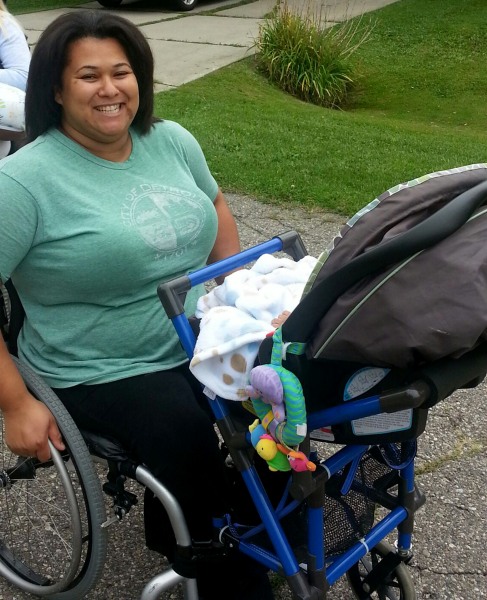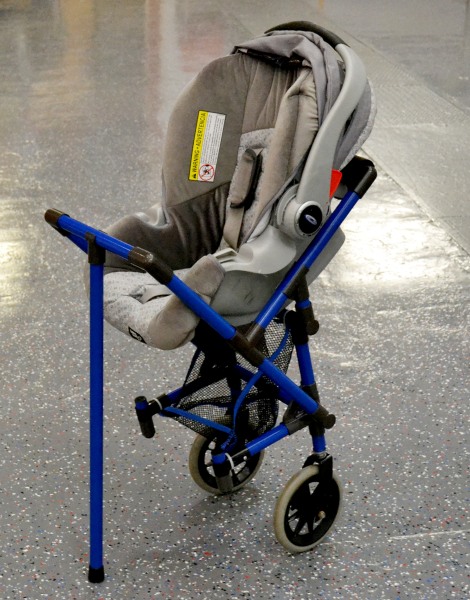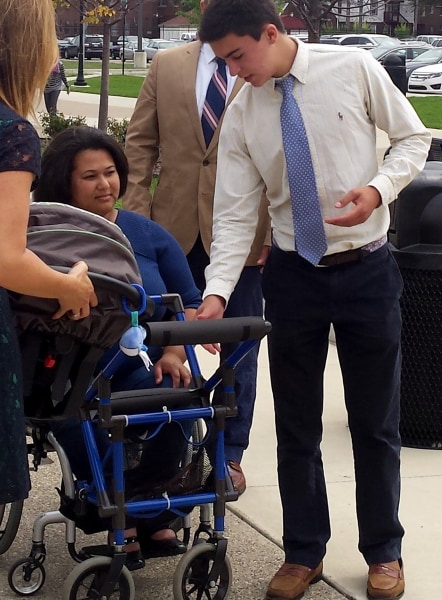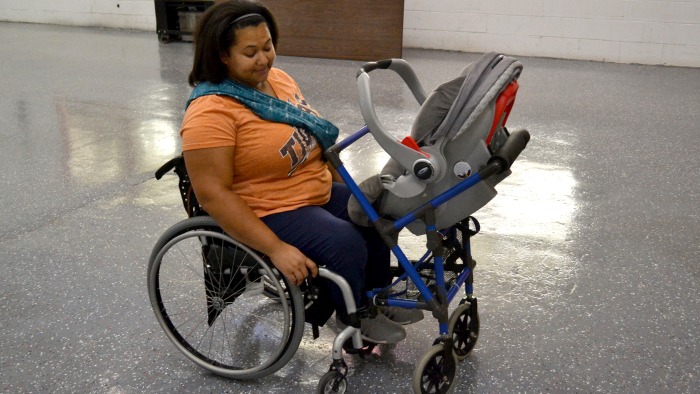Sep. 29, 2015 at 11:24 PM
Terri Peters
Since being shot by another child when she was 5 years old, Sharina Jones has been a paraplegic, using a wheelchair to go about her daily activities. The now-35-year-old has made helping other wheelchair users a life mission — delivering wheelchairs to children in Third World countries through her non-profit organization, Think Beyond the Chair, and motivating others through her blog, Push Goddess.
But when the Detroit, Michigan, resident learned that she and her husband, Grover Jones III, were expecting their first child last fall, she found herself in the position of needing someone else’s help to make her dream of a wheelchair-friendly baby stroller come true.

Jones on a walk with son, Grover, using the wheelchair stroller attachment designed by Alden Kane. Courtesy of Sharina Jones
Jones on a walk with son, Grover, using the wheelchair stroller attachment designed by Alden Kane.
“I was thinking ahead, because you always have to think ahead. After that first doctor’s appointment, we started asking, ‘How are we going to do this? And this? And this?'” said Jones, adding that she wanted the freedom to take her baby on walks, or detach her stroller from her wheelchair and pull up to a restaurant table.
When a friend told Jones about a unique partnership between University of Detroit Mercy and University of Detroit Jesuit High School and Academy — the university works with high school students to give them college-level STEM research projects, some of which are designed to meet the needs of disabled individuals through engineering — she decided to give the program head, Dr. Darrell Kleinke, a call.
Alden Kane, a 16-year-old high school senior enrolled in the program, was assigned to Jones’ project. Kane was tasked with the job of creating a wheelchair stroller and baby carrier that the expectant mother could use when her baby arrived that summer.

Photos taken of the stroller wheelchair attachment when Kane presented it to Jones. Courtesy of Alden Kane
What began as 15 potential designs were slowly whittled down to just one through Alden Kane’s trial and error. Here, the end result.
Kane said he worked for several hours after school every day for six months to come up with the device — drawing plans, making prototypes and testing out different materials. What began as 15 potential designs were slowly whittled down to just one through Kane’s trial and error, and with feedback from Kleinke and Jones.
The final result, made from stainless steel piping with connectors (donated by material company Creform), was ready at the perfect time — when Jones son, Grover IV, was around 2 weeks old.
“It’s not so much a stroller where you’d want to use it independently,” Kane said of his invention. “It’s designed specifically to attach to a wheelchair. In a sense, it is a stroller, but instead of a person pushing it, a wheelchair pushes it.”

Jones and Kane at a school ceremony acknowledging Kane’s achievement.
University of Detroit Jesuit High School
Sharina Jones and Alden Kane at a school ceremony acknowledging Kane’s achievement.
Jones’ son is now 10 weeks old, and the new mom says Kane’s stroller has given her a great deal of freedom, allowing her to shop at the mall, use public restrooms and go for walks with her son, all while knowing he is safe and secure.
“I love it. It makes everything so much easier,” Jones told TODAY Parents.
And, she said she can’t thank Kane enough for his hard work.
“I just love him,” Jones said. “He’s a great kid. He is going to be an amazing engineer.”
“It was extremely exciting and rewarding to see Sharina using it,” Kane said. “Throughout the project, being the only person working on this, I was always wondering if I was going to have it done by the time her child came along … but meeting the due date and having a great working design was just an extremely rewarding sight.”

“I love it,” Jones said of her stroller wheelchair attachment. “It makes everything so much easier.” Courtesy of Alden Kane
Dominic Coccitti-Smith, the instructor for Kane’s high school STEM research course, said the partnership with University of Detroit Mercy has been a wonderful opportunity for his students to grow and learn.
“Alden’s passion for his quest for innovation and improving the lives of our community members came together through this project,” Coccitti-Smith said. “As the instructor for this course, I have great confidence in the future through seeing these wonderful projects that high school students are completing.”
Kane’s plans for the future include studying biomedical engineering or aerospace in college next year. And the teen hopes to patent his design and pursue having it mass-produced by a major stroller or wheelchair company.
“That’s really the end goal here,” he said. “It’s great to have served Mrs. Jones — as one person, it’s had a great impact on her life. But imagine the impact that it could have on hundreds or thousands of lives.”
Jones said she and her husband are enjoying their first weeks as parents, adding that she, too, hopes to see the stroller design become available for more wheelchair-using mothers.
“I’m very thankful for everything that I have, and getting the opportunity to have something like this new stroller,” Jones said. “I’m just very excited about it.”
http://www.today.com/parents/mom-takes-baby-walks-special-wheelchair-stroller-t47011 04032016
